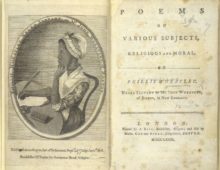Tagged with Peterloo Massacre
Resource : Banner from the “Peterloo Massacre”
On the 16th August 1819, a huge crowd of people gathered in St Peter’s Field, Manchester to hear Henry ‘Orator’ Hunt and other noted radical speakers calling for parliamentary reform. At least 17 people would die of injuries received on the day, and around 700 suffered serious wounds at the hands of local armed forces. There was a popular outcry, and the radical press named the incident the ‘Peterloo Massacre’, a mocking reference to the Battle of Waterloo.
Resource : Metropolitan Police officer
In 1829, the Metropolitan Police – England’s first professional ‘Peelian’ police force – was established. Initially, the force was responsible only for the area within a seven-mile radius of Charing Cross, but this was soon to change, marking a radical new and organised approach to law and order.
Resource : Peterloo commemorative handkerchief
On the 16th August 1819, a huge crowd of people gathered in St Peter’s Field, Manchester to hear Henry ‘Orator’ Hunt and other noted radical speakers calling for parliamentary and social reform. Fearful that the protest could spark a revolution, the authorities panicked and sent for armed forces to disperse the crowd. At least 17 people would die of injuries received on the day, and around 700 suffered serious wounds at the hands of these forces, 200 of them from sabres (a curved sword). There was a popular outcry, and the radical press named the incident the ‘Peterloo Massacre’, a mocking reference to the Battle of Waterloo.
Resource : Creating a historical graphic story
A guide to planning and creating graphic panels and stories with your students, inspired by revolutionary people and events.
Resource : Search is on to trace the descendants of Peterloo veterans
February 19, 2019 - Richard Moss
This photograph of 11 men and women shows the Failsworth Veterans of the Peterloo Massacre at a Great Reform Demonstration in Failsworth, Lancashire (now Greater Manchester) on September 27 1884. A good 65 years after the event, these ageing Victorian veterans were by then in their eighties, but they offered a tangible link with an […]
Resource : Skelmanthorpe Flag
The 1800s saw a series of protests and uprisings in Britain, as people campaigned against slavery, unjust taxes and laws imposed by the government and in support of fair wages, the right to vote and to have their voices heard in parliament. Protest flags, posters and banners carrying radical slogans were a popular way for campaigners to get their message across at marches and rallies, and to cooperate without endangering individuals. The Skelmanthorpe flag was created in secret, in Huddersfield, initially to honour the victims of what became known as the Peterloo Massacre, in 1819.
Resource : Mike Leigh, the Historical Association and Peterloo
November 1, 2018 - Richard Moss
Mike Leigh talks about the historical sources for his groundbreaking film Peterloo with his historical adviser, the author and historian Jacqueline Riding, in this snippet from an interview with the Historical Association. The Historical Association website also offers some intersting resources and insights into the history of radicalism during the Age of Revolution – inlcuding […]
Resource : British politics in the Age of Revolution
The continued calls for the reform of British politics and representation of marginalised sectors of society, and the establishment’s unprecedented measures to restrict and suppress these ‘radical’ ideas and demands.


